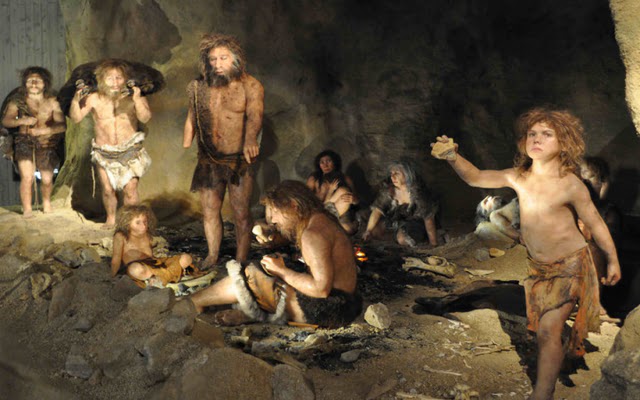
Imagine going back in time. It’s 1856, and you’re working in a quarry in the Neander Valley near Dusseldorf, Germany. In a cave called Feldhofer Cave, you and your fellow workers discover 16 bone fragments, including a skull!
At first, you think the bones belong to a bear, so you give them to a local teacher named Johan Karl Fuhlrott. Eventually, the bones are examined by scientists who are unsure of their origin, as they do not resemble anything they have seen before.
After the publication of Charles Darwin’s The Origin of the Species in 1859, the bones are reexamined and identified as fossils of an ancient relative of modern humans. In 1864, geologist William King names this ancient human species Homo neanderthalensis, based on the location where the bones were found.
Since then, over 400 Neanderthal bones have been discovered. In fact, earlier fossil findings in Belgium in 1829 and Gibraltar in 1848 were also identified as Neanderthals.
So who were the Neanderthals? Scientists now believe that Neanderthals were the closest extinct relatives of modern humans, sharing approximately 99.7% of their DNA. While many scientists consider them a separate species (Homo neanderthalensis), some believe they may be a subspecies of modern humans (Homo sapiens).
The Neanderthals inhabited Europe and Asia during the Pleistocene Epoch, also known as the Ice Age. It is estimated that they became extinct around 30,000-40,000 years ago.
The reason for the extinction of the Neanderthals remains unknown. Some speculate that it was due to drastic climate change, while others believe that modern humans were responsible for their demise. A more recent theory suggests that Neanderthals interbred with modern humans and eventually assimilated into our species.
Neanderthals had a similar appearance to modern humans, although they were generally shorter and stockier. Their bodies were adapted for cold weather, as they lived during the Ice Age.
In order to survive in icy conditions, many Neanderthals sought shelter in limestone caves across Europe and Asia. They are often referred to as “cave men” because many Neanderthal fossils have been found in caves.
Neanderthals had large, complex brains similar to those of modern humans. They created and used tools, controlled fire, and buried their dead. It is believed that they lived in nuclear families and took care of sick and elderly family members who were unable to care for themselves.
It is uncertain whether Neanderthals had a developed language, but given the size and complexity of their brains, it is considered a likely possibility. They also made and wore clothes. Although they hunted large animals, they regularly cooked and ate vegetables. The average lifespan of a Neanderthal was around 30 years.
Try It Out
Are you interested in learning more about the Neanderthals? Ask a friend or family member to assist you in exploring the following activities:
Explore Neanderthal Behaviors
Go to the PBS website and watch the documentary “A Neanderthal Burial” to gain a deeper understanding of the ancient behaviors that Neanderthals may have practiced. If Neanderthals did indeed bury their dead, what implications does this have about their culture and beliefs?
Take a look at the online exhibit “Neanderthal Tools” by the American Museum of Natural History. Consider the various tasks that Neanderthals may have used these tools for. Additionally, contemplate why scientists consider these tool discoveries to be significant.
Discover how scientists are able to determine what Neanderthals looked like by exploring the online resource “Neanderthal Reconstruction.” This will provide insights into the techniques utilized by scientists to reconstruct the physical appearance of Neanderthals based on ancient skeletal remains.
Additional Resources
- For more information about Neanderthals, visit the following sources:
- http://www.livescience.com/28036-neanderthals-facts-about-our-extinct-human-relatives.html
- http://humanorigins.si.edu/evidence/human-fossils/species/homo-neanderthalensis
FAQ
1. What were the Neanderthals?
The Neanderthals were a species of ancient humans who lived in Europe and parts of Asia from about 400,000 to 40,000 years ago. They were closely related to modern humans and shared a common ancestor with us. Neanderthals had a robust build and were well adapted to the cold environments they lived in. They had a larger brain size than modern humans and were skilled hunters and toolmakers.
2. How did the Neanderthals live?
The Neanderthals lived in small groups and were primarily hunter-gatherers. They relied on hunting large game, such as mammoths and bison, for food. They also gathered plants and berries and may have used fire for warmth and cooking. Neanderthals were skilled toolmakers and used stone tools for various tasks. They also had a complex social structure and likely had rituals and ceremonies.
3. What happened to the Neanderthals?
The exact reason for the extinction of the Neanderthals is still debated among scientists. One theory suggests that they were outcompeted by modern humans, who had more advanced cognitive abilities and better social organization. Another theory suggests that they interbred with modern humans and gradually assimilated into the population. Recent genetic studies have shown that modern humans of non-African descent have a small percentage of Neanderthal DNA, indicating some interbreeding did occur.
4. What can we learn from studying Neanderthals?
Studying Neanderthals provides valuable insights into our evolutionary history and the origins of modern humans. By examining their physical remains and artifacts, scientists can learn about their lifestyle, behavior, and technological advancements. Comparative studies between Neanderthals and modern humans can help us understand the unique traits and adaptations that allowed our species to survive and thrive. Additionally, studying Neanderthals can shed light on the factors that contribute to the extinction of species and the dynamics of human evolution.





Leave a Reply